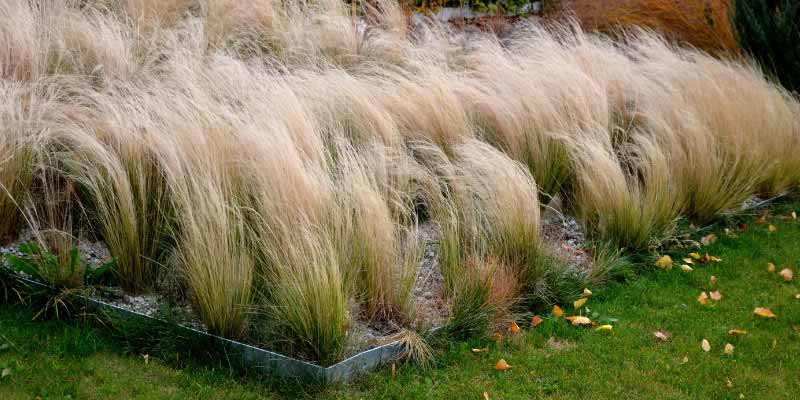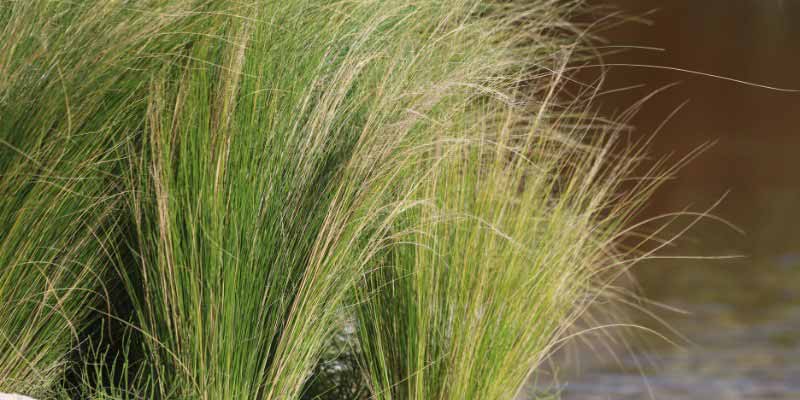Stipas are light and graceful ornamental grasses, prized for their flexible habit, finely textured foliage, and silky spikes. They add lightness to natural compositions and soften the clean lines of minimalist gardens. Indispensable in recent years, they stand out as one of the most beautiful flowering grasses. Hardy and unfazed by challenging conditions, stipas thrive in all types of gardens, from wild to contemporary. From Stipa tenuifolia (or Stipa tenuissima), nicknamed "angel hair", to the majestic Stipa gigantea and the delicate Stipa capillata, these varieties offer a luminous mane year-round that catches the light under dew or frost. Resistant to wind, heat, and drought, stipas flourish in full sun in dry or well-drained soil. They require minimal maintenance but need special care: combing. Stipa care is limited to "brushing" the clump. This simple gesture preserves their natural beauty throughout the year.
In this tutorial, discover how and why to comb your stipas to keep them beautiful and healthy.

Stipas: ornamental grasses that need combing
Stipas are evergreen grasses in mild climates or semi-evergreen, recognisable by their fine and light foliage. They sway gracefully in the wind, adding lightness and a natural touch to compositions. The evergreen foliage of stipas doesn’t flop like other grasses but is gently combed by hand (wearing gloves) or with a rake or claw. On this topic, read: Ornamental grasses: those you prune, those you comb.
Why comb stipas?
As evergreen grasses, stipas retain their foliage year-round. Unlike Miscanthus, Panicum, or Calamagrostis, which are cut back to the ground, stipas simply need combing to preserve their natural habit. Combing helps to:
- remove dead leaves and dried stems,
- aerate the clump and stimulate new leaf growth,
- maintain the airy and fluid appearance of the plant,
- prevent diseases caused by moisture stagnation and avoid suffocation.

When to comb stipas?
Combing stipas is typically done in late winter, between February and March, just before new growth begins.
How to comb stipas?
Required materials
- A pair of gardening gloves to protect your hands,
- A rake, a leaf rake, or a claw to remove dead leaves.
- Protect your hands with gloves.
- Use a leaf rake or your hands.
- Gently comb the leaves from the bottom upwards to remove as many dead leaves as possible. Avoid pulling too hard to prevent damaging fragile old stumps. If some clumps don’t come off easily, it’s a sign they need dividing to rejuvenate older plants.
- Clean around the plant by removing debris.
Gardening tip: To prevent dead leaves from accumulating, comb your stipas after a dry spell when the leaves are dry and easy to remove.

Caring for stipas after combing
Watering
Stipa is a resilient plant, perfect for sustainable, low-maintenance, and water-wise gardens. It tolerates cold and drought well, and once established, it doesn’t need watering. However, remember to water potted stipas, as they’ll need more moisture, especially during hot and windy weather. Watering should be balanced to avoid both drought and excess moisture:
- Water your stipas regularly during the first year after planting to help the roots establish.
- Afterwards, water only during prolonged dry spells. Ensure the water penetrates the soil but avoid waterlogging around the roots.
- Stipas dislike excess moisture! Poorly drained soil or frequent watering can cause rot.
Fertilisation
Stipas thrive in poor, dry soils. Fertiliser is not only unnecessary but harmful to the plant. It would only make them more susceptible to diseases and rot.
Diseases
Stipas are generally disease-resistant, but it’s important to watch for common issues. Fungal diseases can be a problem, especially in damp conditions.
- Rust: This fungal disease appears as orange or brown spots on the leaves. Spray with horsetail decoction or possibly nettle liquid fertiliser. To neutralise rust, you can also use Bordeaux mixture.
- Root rot: Caused by excess moisture, it can be prevented by ensuring good soil drainage.
Cutting back
It’s beneficial to cut back stipas to 10-15 cm from the ground every 2-3 years to rejuvenate clumps. This encourages new leaf growth and prevents the stump from hollowing out.
Division
Divide stipa clumps every 3 to 5 years in spring or early autumn to prevent them from becoming too dense and to maintain vigour. Dig up the plant, separate the clumps with a spade or knife, and replant immediately. For more details, watch our video guide Dividing an ornamental grass.
Clean around the clumps
- Weed regularly around stipas to avoid competition for water and nutrients.
- Remove fallen dead leaves to limit moisture and diseases.
































Comments